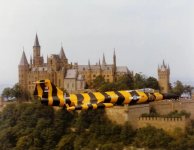The
Runit Dome, also called
Cactus Dome or locally "the Tomb", is a 115 m (377 ft) diameter,
[2] 46 cm (18 in) thick dome of concrete at
sea level, encapsulating an estimated 73,000 m3 (95,000 cu yd) of radioactive debris, including some
plutonium-239. The debris stems from
nuclear tests conducted in the Enewetak Atoll by the United States between 1946 and 1958.
From 1977 to 1980, loose waste and topsoil from six different islands in the Enewetak Atoll was transported to the site and mixed with concrete to seal the nuclear blast crater created by the
Cactus test. Four thousand US servicemen were involved in the cleanup from this test, and it took three years to complete. The waste-filled crater was finally
entombed in concrete.
In 1982, a US government task force raised concern about a probable breach if a severe
typhoon were to hit the island. In 2013, a report by the
US Department of Energy found that the concrete dome had weathered with minor cracking of the structure.
However, the soil around the dome was found to be more contaminated than its contents, so a breach could not increase the radiation levels by any means. Because the cleaning operation in the 1970s only removed an estimated 0.8 percent of the total
transuranic waste in the Enewetak atoll, the soil and the lagoon water surrounding the structure now contain a higher level of
radioactivity than the debris of the dome itself, so even in the event of a total collapse, the radiation dose delivered to the local resident population or marine environment should not change significantly.
Concern primarily lies in the rapid tidal response to the height of the water beneath the debris pile, with the potential for contamination of the groundwater supply with radionuclides. One particular concern is that, in order to save costs, the original plan to line the porous bottom crater with concrete was abandoned. Since the bottom of the crater consists of permeable soil, there is seawater inside the dome.
However, as the Department of Energy report stated, the released radionuclides will be very rapidly diluted and should not cause any elevated radioactive risk for the marine environment, compared to what is already experienced. Leaking and breaching of the dome could however disperse
plutonium, a radioactive element that is also a
toxic heavy metal.
An investigative report by the
Los Angeles Times in November 2019 reignited fears of the dome cracking and releasing radioactive material into the soil and surrounding water. The DOE was directed by Congress to assess the condition of the structure and develop a repair plan during the first half of 2020. The report was published in June 2020.
In June 2020, the US Department of Energy released a report stating that the dome is in no immediate danger of collapse or breach and that the radioactive material within is not expected to have any measurable adverse effect on the surrounding environment for the next twenty years.
















































































